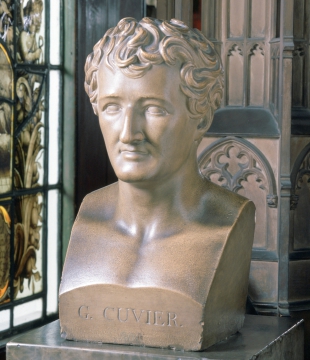Explore Collections


You are here:
CollectionsOnline
/
Bust of Baron Georges Cuvier (1769-1832)
Browse
Louis-Parfait Merlieux (1796 - 1855), sculptor
Bust of Baron Georges Cuvier (1769-1832)
Plaster
Height: 36.5cm
Inscription: P Merlieux 1827 [on the back]
Museum number: M306
On display: Basement Ante-Room
Curatorial note
Georges Cuvier was one of the world's greatest naturalists. His pioneering studies, comparing living creatures with fossils, helped to establish the fields of paleontology and comparative anatomy. He also established 'extinction' as an accepted scientific phenomenon and is known for having opposed early theories of evolution (pre-Darwin). He worked for most of his career at the Jardin des Plantes (later the National Museum of Natural History) in Paris, where he gave his first series of lectures in 1795. He refused an invitation to become a naturalist on Napoleon’s expedition to Egypt in 1798–1801 in order to continue his research there.
Soane owned a copy of Vol. 1 ofThe Animal Kingdom, the English translation of Cuvier's most famous work Le Règne Animal (1817) which was published in English in several volumes between 1827 and 1835. The volume in Soane's collection was presented to him and bound in 1830.
In his 1835 Description Soane notes that this bust of Cuvier is 'said to be an excellent likeness', from which we can deduce that he never met Cuvier personally.
In addition to knowing of his scientific work Soane may have admired Cuvier for his promotion of public museums and role in establishing provincial French universities and must have heard of him first-hand from Sir Thomas Lawrence. The fact that Cuvier was a surgeon general to Napoleon in 1815 may also have made him a figure of interest to Soane. Cuvier was elected as a foreign member of the Royal Society (1806) but never visited England.
Soane owned a copy of Vol. 1 ofThe Animal Kingdom, the English translation of Cuvier's most famous work Le Règne Animal (1817) which was published in English in several volumes between 1827 and 1835. The volume in Soane's collection was presented to him and bound in 1830.
In his 1835 Description Soane notes that this bust of Cuvier is 'said to be an excellent likeness', from which we can deduce that he never met Cuvier personally.
In addition to knowing of his scientific work Soane may have admired Cuvier for his promotion of public museums and role in establishing provincial French universities and must have heard of him first-hand from Sir Thomas Lawrence. The fact that Cuvier was a surgeon general to Napoleon in 1815 may also have made him a figure of interest to Soane. Cuvier was elected as a foreign member of the Royal Society (1806) but never visited England.
In his 1835 Description Soane records that this bust was 'formerly in the possession of Sir Thomas Lawrence P.R.A., to whom it was presented by Madame Cuvier'. Lawrence certainly met the Cuviers during a visit to Paris in 1825 and perhaps earlier. He was in Paris in September 1815 after the fall of Napoleon and then, between 1818 and 1820, travelled exensively from Aix-en-Provance to Vienna and Rome painting portraits of the victorious Allied sovereigns. He made a final trip to Paris in August 1825 to paint Charles X. There is a note in the Royal Academy archive from Anne Cuvier to Thomas Lawrence, thought to date from 1825, in which she thanks Lawrence for the invitation and says they will call 'tomorrow', along with some other correspondence between Lawrence and Cuvier in 1825-26. Lawrence is also said to have painted a portait of Cuvier's daughter-in-law (his step-daughter - none of his own children survived infancy), which was sent over to him from England (Memoirs of Baron Cuvier by Mrs R. Lee, 1833, p.277).
Literature
J. Soane, Description, 1835, p.31
Soane collections online is being continually updated. If you wish to find out more or if you have any further information about this object please contact us: worksofart@soane.org.uk


